Unit 1 Living with technology project
文档属性
| 名称 | Unit 1 Living with technology project |  | |
| 格式 | rar | ||
| 文件大小 | 2.5MB | ||
| 资源类型 | 教案 | ||
| 版本资源 | 牛津译林版 | ||
| 科目 | 英语 | ||
| 更新时间 | 2011-04-09 07:50:00 | ||
图片预览

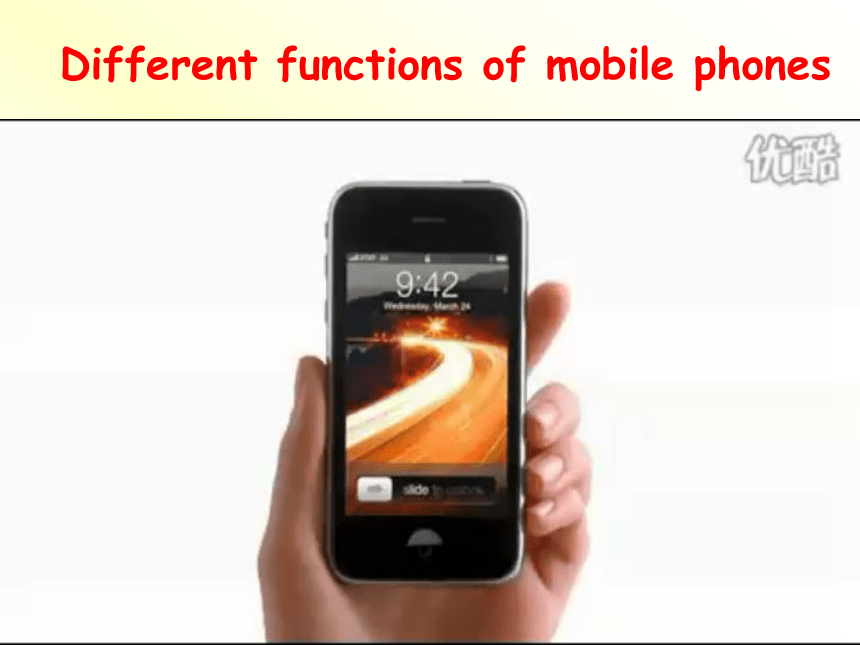
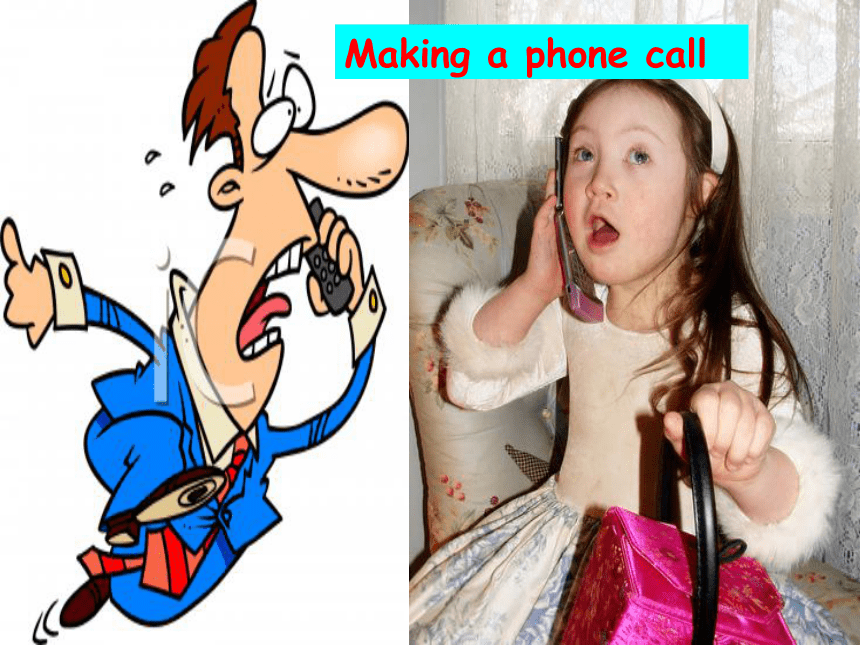

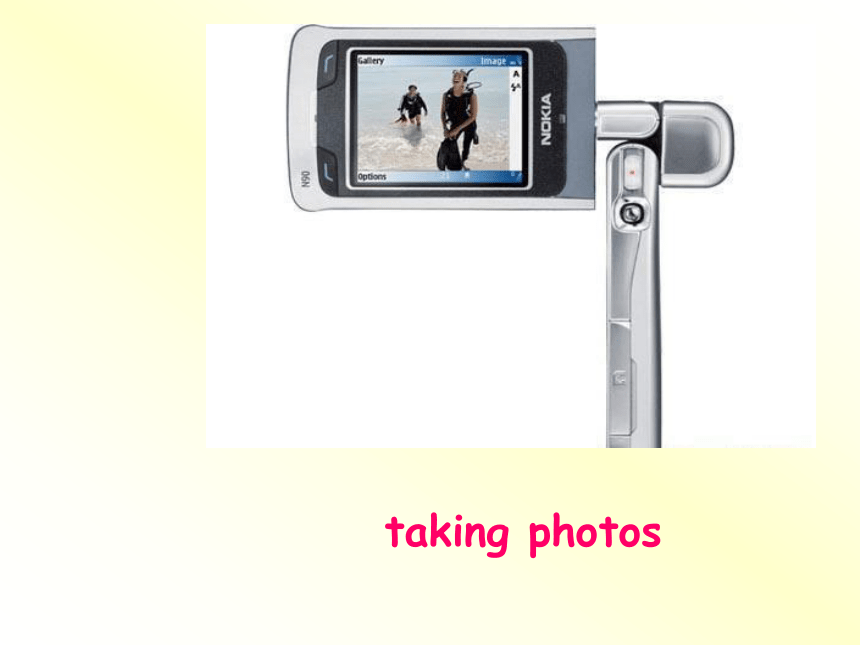
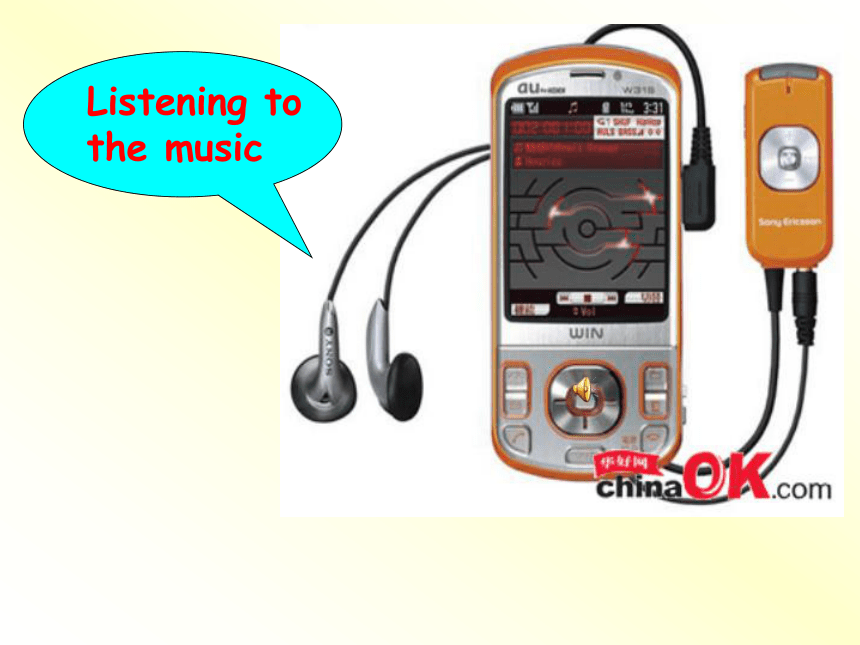

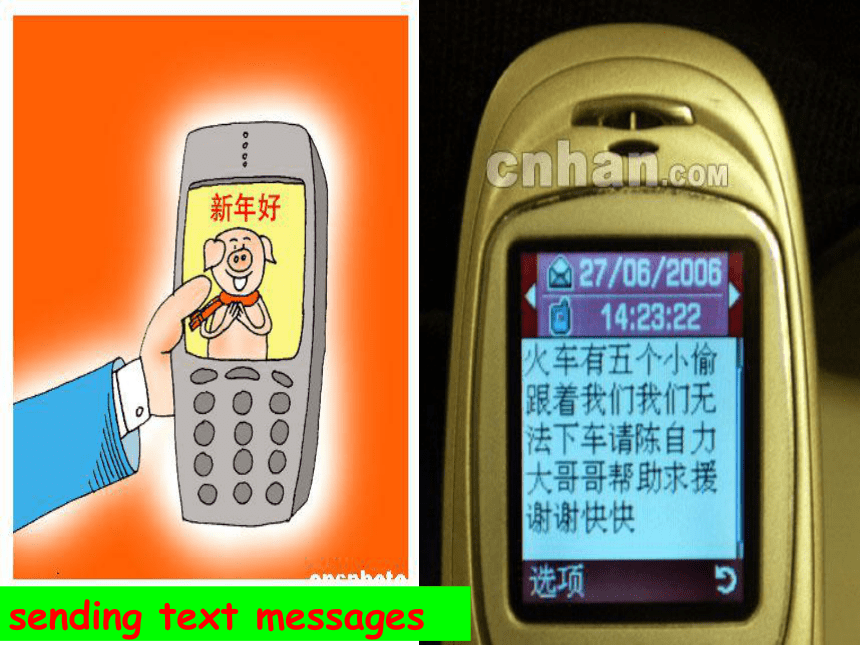
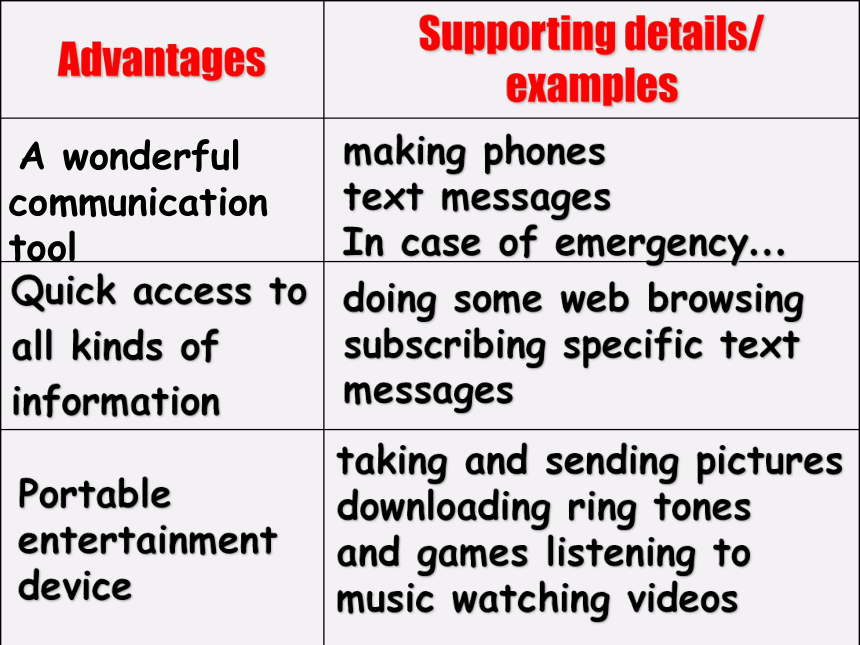
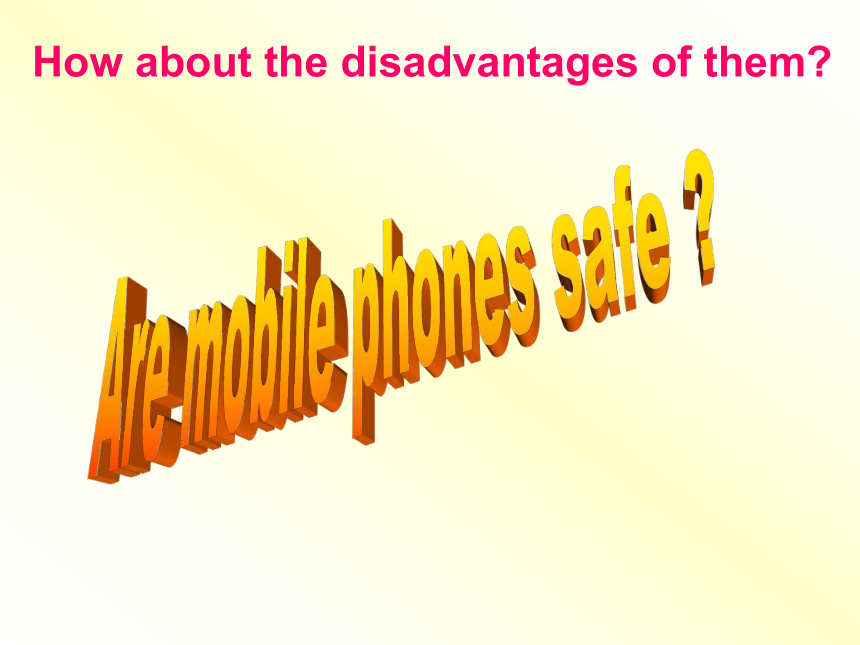
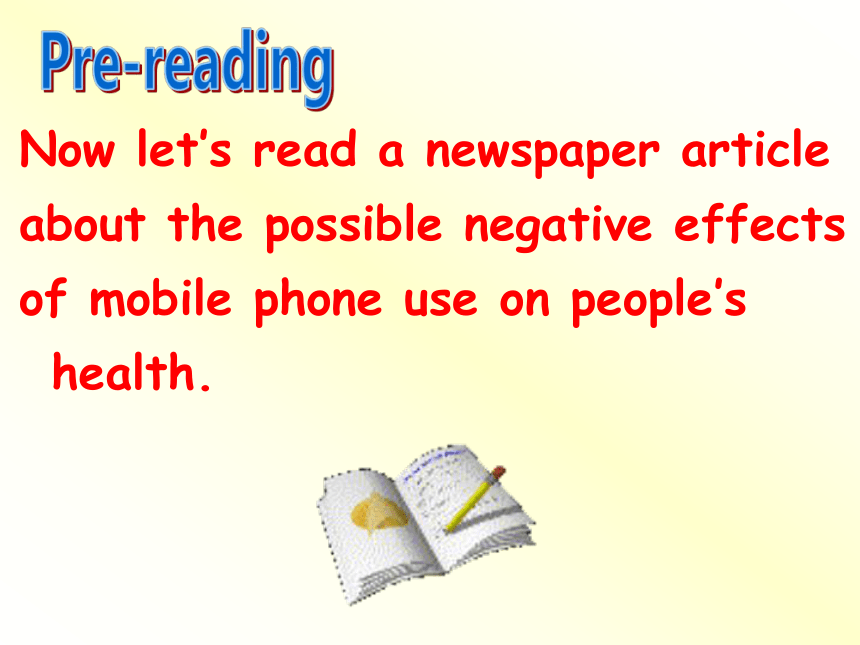
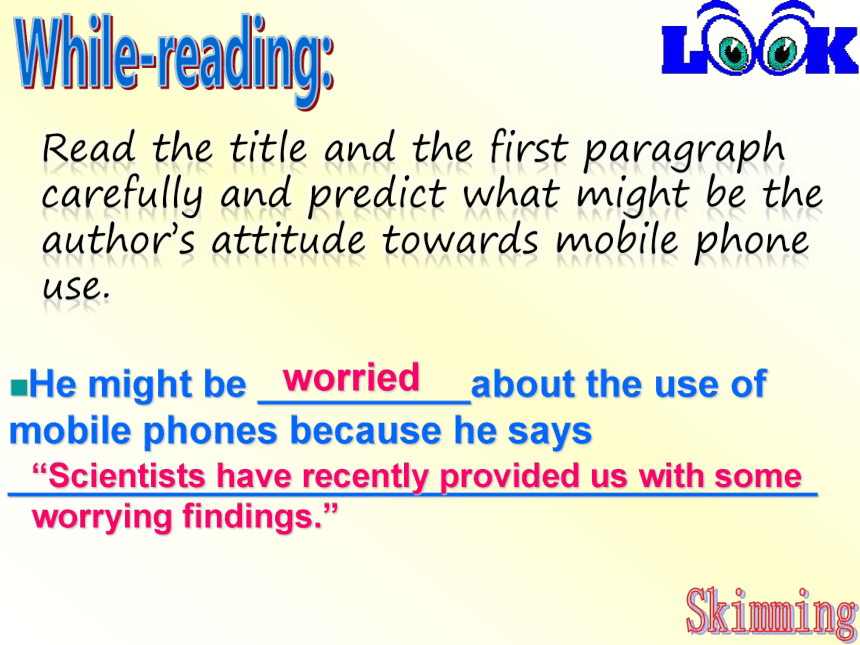
文档简介
课件33张PPT。Unit 1 ProjectMaking a list of pros and cons Different functions of mobile phonesMaking a phone callPlaying gamestaking photosListening to the music Surfing the Internetsending text messages A wonderful
communication toolQuick access to
all kinds of
information
Portable
entertainment
devicemaking phones
text messages
In case of emergency…doing some web browsing
subscribing specific text
messagestaking and sending pictures
downloading ring tones
and games listening to music watching videosAre mobile phones safe ?How about the disadvantages of them?Now let’s read a newspaper article
about the possible negative effects
of mobile phone use on people’s health.
Pre-readingRead the title and the first paragraph carefully and predict what might be the author’s attitude towards mobile phone use.
He might be __________about the use of mobile phones because he says ______________________________________worried“Scientists have recently provided us with some worrying findings.”SkimmingWhile-reading:Careful readingPlease read the article carefully and then try to find more information about disadvantages of mobile phones.What has the British Association for the Advancement of Science reported?
2. What is the report based on? 4. Why is there no definite scientific evidence available now about the effects of mobile phones on people’s health?5. What’s the attitude of Professor Tony Basten towards mobile phones? And what about Sir William Stewart?
3.Why is the work that Harris and his colleagues did very important?
Questions:Detailed-readingWhat has the British Association for the Advancement of Science reported?
It has reported that using a mobile phone doubles the risk of developing brain cancer, a disease which is usually terminal.
2. What is the report based on?
It is based on the findings of research that was carried out in Sweden, comparing 1,617 patients found to have brain tumours between 1997 and 2003 with the same number of healthy people.
3.Why is the work that Harris and his colleagues did very important?
Because it says that there is a definite and direct link between mobile phones use and cancer.4. Why is there no definite scientific evidence available now about the effects of mobile phones on people’s health?
One theory is that it is not available because the telecommunications industry is huge, and the amount of profit involved is enormous.5. What’s the attitude of Professor Tony Basten towards mobile phones? And what about Sir William Stewart?
Professor Tony Basten has supported the industry while Sir William Stewart would support higher pricing to reduce use of mobiles by children.
Listening:Listen to the passage and try to find the main points according to the supporting details.Supporting details:1
The report is based on the findings of research that was carried out in Sweden, comparing 1,617 patients found to have brain tumours between 1997 and 2003 with the same number of healthy people.
Supporting details:2
The study was conducted with 200 mice, half of which were exposed to radiation while the other half did not receive any radiation. The amount of radiation was equal to using a mobile phone for two half-hour periods per day. It was found that after eighteen months, the first half had more than twice the cancer rate of the second half.
Supporting details:3
Enormous profit from the telecommunications industry prevents the bad results of findings from being exposed/revealed.
Main point 1: (Para 2-3)Using a mobile phone doubles the risk of developing brain cancer.Supporting details:1
The report is based on the findings of research that was carried out in Sweden, comparing 1,617 patients found to have brain tumours between 1997 and 2003 with the same number of healthy people.
Main point 2 (Para4-6)Digital mobile phones are an actual danger.Supporting details:2
The study was conducted with 200 mice, half of which were exposed to radiation while the other half did not receive any radiation. The amount of radiation was equal to using a mobile phone for two half-hour periods per day. It was found that after eighteen months, the first half had more than twice the cancer rate of the second half.Main point 3 (Para 7-8)
The reasons why there is no definite scientific evidence available now about the effects of mobile phones on people’s healthSupporting details:3
Enormous profit from the telecommunications industry prevents the bad results of findings from being exposed/revealed.
DisadvantagesTry your best to list out the disadvantages of mobile phones . interfere with the classroom order
be a waste of study time
increase financial burden on parents
produce radiation
………DisadvantagesPost-reading:Discussion:
Tips to enjoy safe use of mobile phones:I would recommend against…
It is suggested / My suggestion is that…
People are strongly advised that…
Never/ Avoid…
It is very important (not) to…
Try and limit…Useful expressionsTips on using mobile phones:
1.While communicating, ?keep the cell phone away from the body?as much as possible.
2. Avoid carrying your cell phone on your body at all times
3. Avoid using your cell phone while driving
4. When possible,?communicate via text messaging
rather than making a call.
5. Do not use the cell phone in elevators.
6. Do not make a call when the signal strength is
one bar or less.
As we have learnt how to make a statement and how to support it, now you are expected to complete the project to make a list of pros and cons on electronic devices.
Project time:Advantages and disadvantages of computer use/ Mp3/ TV…… Chose a topic and discuss with your partners on this topic. Then write a list of the advantages and disadvantages of ……Make a speech on the advantages and
disadvantages of using the electronic or
electrical device your group have chosen.
◆ Suggested structure:
☆ Introduction
☆ Advantages (supporting details)
☆ Disadvantages (supporting details)
☆ ConclusionAssignment:Useful expressionsIt is said that…/ It is acknowledged that…
Sb. believed/ thought that
hold an opinion that
additionally/ in addition
on the other hand
in the same way
…
SHOW TIME1 Read the article until you are familiar with it.
2 List the difficult language points on your notebook.Homework:THE END
Thank you !
communication toolQuick access to
all kinds of
information
Portable
entertainment
devicemaking phones
text messages
In case of emergency…doing some web browsing
subscribing specific text
messagestaking and sending pictures
downloading ring tones
and games listening to music watching videosAre mobile phones safe ?How about the disadvantages of them?Now let’s read a newspaper article
about the possible negative effects
of mobile phone use on people’s health.
Pre-readingRead the title and the first paragraph carefully and predict what might be the author’s attitude towards mobile phone use.
He might be __________about the use of mobile phones because he says ______________________________________worried“Scientists have recently provided us with some worrying findings.”SkimmingWhile-reading:Careful readingPlease read the article carefully and then try to find more information about disadvantages of mobile phones.What has the British Association for the Advancement of Science reported?
2. What is the report based on? 4. Why is there no definite scientific evidence available now about the effects of mobile phones on people’s health?5. What’s the attitude of Professor Tony Basten towards mobile phones? And what about Sir William Stewart?
3.Why is the work that Harris and his colleagues did very important?
Questions:Detailed-readingWhat has the British Association for the Advancement of Science reported?
It has reported that using a mobile phone doubles the risk of developing brain cancer, a disease which is usually terminal.
2. What is the report based on?
It is based on the findings of research that was carried out in Sweden, comparing 1,617 patients found to have brain tumours between 1997 and 2003 with the same number of healthy people.
3.Why is the work that Harris and his colleagues did very important?
Because it says that there is a definite and direct link between mobile phones use and cancer.4. Why is there no definite scientific evidence available now about the effects of mobile phones on people’s health?
One theory is that it is not available because the telecommunications industry is huge, and the amount of profit involved is enormous.5. What’s the attitude of Professor Tony Basten towards mobile phones? And what about Sir William Stewart?
Professor Tony Basten has supported the industry while Sir William Stewart would support higher pricing to reduce use of mobiles by children.
Listening:Listen to the passage and try to find the main points according to the supporting details.Supporting details:1
The report is based on the findings of research that was carried out in Sweden, comparing 1,617 patients found to have brain tumours between 1997 and 2003 with the same number of healthy people.
Supporting details:2
The study was conducted with 200 mice, half of which were exposed to radiation while the other half did not receive any radiation. The amount of radiation was equal to using a mobile phone for two half-hour periods per day. It was found that after eighteen months, the first half had more than twice the cancer rate of the second half.
Supporting details:3
Enormous profit from the telecommunications industry prevents the bad results of findings from being exposed/revealed.
Main point 1: (Para 2-3)Using a mobile phone doubles the risk of developing brain cancer.Supporting details:1
The report is based on the findings of research that was carried out in Sweden, comparing 1,617 patients found to have brain tumours between 1997 and 2003 with the same number of healthy people.
Main point 2 (Para4-6)Digital mobile phones are an actual danger.Supporting details:2
The study was conducted with 200 mice, half of which were exposed to radiation while the other half did not receive any radiation. The amount of radiation was equal to using a mobile phone for two half-hour periods per day. It was found that after eighteen months, the first half had more than twice the cancer rate of the second half.Main point 3 (Para 7-8)
The reasons why there is no definite scientific evidence available now about the effects of mobile phones on people’s healthSupporting details:3
Enormous profit from the telecommunications industry prevents the bad results of findings from being exposed/revealed.
DisadvantagesTry your best to list out the disadvantages of mobile phones . interfere with the classroom order
be a waste of study time
increase financial burden on parents
produce radiation
………DisadvantagesPost-reading:Discussion:
Tips to enjoy safe use of mobile phones:I would recommend against…
It is suggested / My suggestion is that…
People are strongly advised that…
Never/ Avoid…
It is very important (not) to…
Try and limit…Useful expressionsTips on using mobile phones:
1.While communicating, ?keep the cell phone away from the body?as much as possible.
2. Avoid carrying your cell phone on your body at all times
3. Avoid using your cell phone while driving
4. When possible,?communicate via text messaging
rather than making a call.
5. Do not use the cell phone in elevators.
6. Do not make a call when the signal strength is
one bar or less.
As we have learnt how to make a statement and how to support it, now you are expected to complete the project to make a list of pros and cons on electronic devices.
Project time:Advantages and disadvantages of computer use/ Mp3/ TV…… Chose a topic and discuss with your partners on this topic. Then write a list of the advantages and disadvantages of ……Make a speech on the advantages and
disadvantages of using the electronic or
electrical device your group have chosen.
◆ Suggested structure:
☆ Introduction
☆ Advantages (supporting details)
☆ Disadvantages (supporting details)
☆ ConclusionAssignment:Useful expressionsIt is said that…/ It is acknowledged that…
Sb. believed/ thought that
hold an opinion that
additionally/ in addition
on the other hand
in the same way
…
SHOW TIME1 Read the article until you are familiar with it.
2 List the difficult language points on your notebook.Homework:THE END
Thank you !
